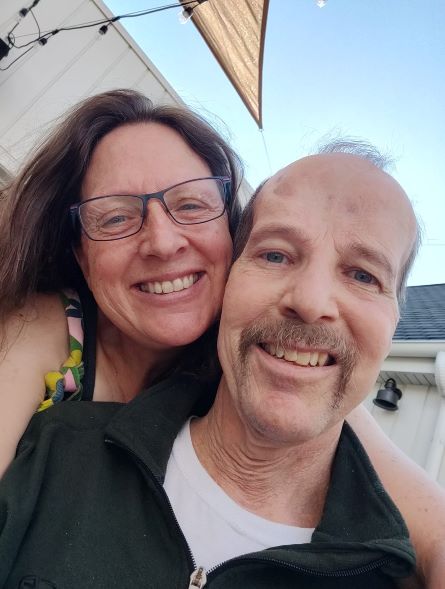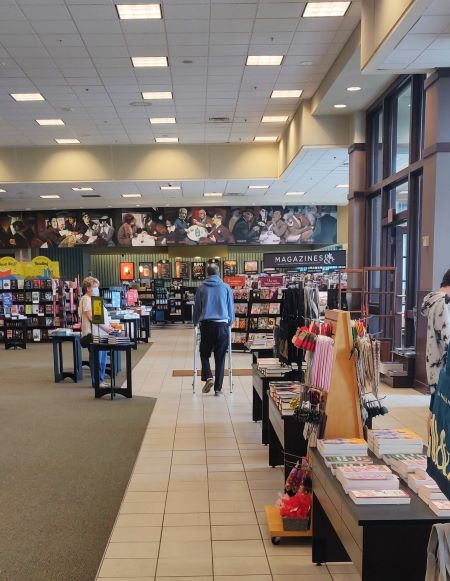Sometimes, I post pictures that make me feel better. Sometimes, I post them to make you feel better, if I’m to be completely honest. Like this one. Check us out.

Cute, right? We went out to a local restaurant for a beer. It was a nice night. I could leave it at that, giving you the understanding that Mark and I can relax and smile and things are good. But our moments are rarely that simple. Thirty minutes into our time there, I stepped away from the table to take a phone call from the PCP to discuss Mark’s DNR status. I made decisions that you don’t want to have to make. Then I went back to the table to continue discussing the Rolling Stone Magazine’s newest top 500 Best Songs list with Mark. What did he agree with? What didn’t he? This was me choosing a conversation that I knew would engage but also would be cognitive exercise. When we stood up to leave, I had to remind Mark that he had brought in his walker.
When I added this photo to my computer files, I entitled it, “Not Dead Yet,” which is my theme for my year. I’m not referring to Mark; I am talking about me. Because when you’re faced with your husband going off the medical rails as far as Mark has, you get subsumed. You have to claw your way through most days. You have to build your own ladder and climb it over and over again to remind yourself that there is still a sun, moon, and stars up in the big glorious sky above. And I am committed to doing that, clawing and climbing, for myself but also for Mark and his kids who like parasites can only live if their host is thriving. This host has been slipping on the thriving scale; my caregiving lifestyle is starting to eat through the broadcloth of my own life, leaving me vulnerable to the elements.
Like any good survivor, I noticed this and starting looking for options. At over two years into taking care of Mark and having honed myself into a caregiving machine, there remains no end in sight. This machine needs a break and a tune-up. A real break, one in which I can turn off my laser-focus on Mark and nurture the other parts of me. Mark currently is medically stable, a window I do not take for granted, and so leaving him under the care of others for a few days seemed like a reasonable possibility. I am very protective of Mark, you may have noticed, and for me to get a break meant identifying the best option for his care. If you are a parent to human children or even fur babies, you get it. Your heart locked in, you aim for it all. Their safety and wellbeing is the solid foundation. Then you want layers. Happiness, fulfillment, contentment, joy, love, and on and on. On top of Mark’s wellbeing to plan for, there’s Matthew. At 16, he is the kind of kid that will let the dogs out, eat a balanced diet, and go to school whether I’m here or not. And yet. I want the layers for him. Happiness, joy, love… all the things. Life has been cruel to him, taking away both his parents, and I aim to soften those harsh edges.
I turned to the obvious best choice for Mark and Matthew. Mark’s family of many siblings. I explained the need (Diane recharges her batteries), the desire (Mark is in his home environment and maintains routines; Matthew has another adult who cares about him present). I asked if they could, among them, arrange to stay with Mark for four days sometime this fall. All I can say about this is the facts. I asked. The answer was no. From what I was told, this does not fall into their definition of what a family should be asked to do.
I moved on to the only other option. Yesterday, I placed Mark into a locked memory care unit at a senior living facility. With a thirty day minimum respite stay that I negotiated down to two weeks, the four day break I wanted is now $3,000 long. I am worried about how Mark will fare. The medical practitioners tell me to expect a setback, cognitively and physically. I hope to not get difficult phone calls from Mark. I hope Mark doesn’t get Covid, as this placement increases his risk factors significantly. I hope he doesn’t fall, as he will be watched less than if he was at home. I hope he settles in and finds a routine that works for him. I hope the staff is loving and kind, and that they engage with him and respect him.
This is not ideal. However, I am accepting that this is what I must do, for myself, in order to keep my own health and wellbeing in check. I’ll do what I always do with any time I find: pack it with all the joy, peace, and fun available. I’ll stay home the first week so that Matthew has transition time and a sense of stability. The neighborhood moms will wrap him in love and support like a surrogate family. Then I’m going to leave western Pennsylvania for the first time in two years. I’ll post photos of my trip to visit Alma and Adam in western Massachusetts, and you’ll think, “She’s doing great!” and like all social media posts, that may or may not be the whole story.
My goal is to come back to Mark and Matthew refreshed and energetic for this continuing journey. Because whatever the hurdles, keep going I must.
